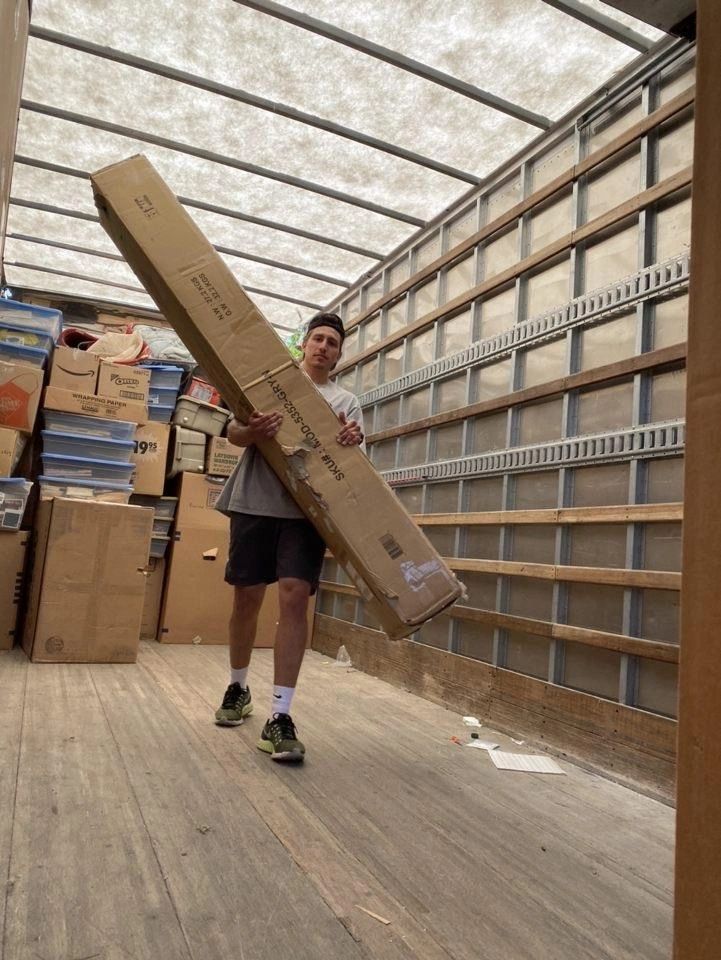Understanding the Inclusions of moving and Freight Forwarding on the planet of Residential and International Delivery
Steering via the intricacies of moving and Freight forwarding can be difficult. Both procedures include distinctive treatments and requirements that are important for successful transportation. Recognizing the distinctions in logistics, paperwork, and threat administration is necessary for individuals and companies alike. This expertise can significantly influence the performance and security of deliveries. Nevertheless, numerous are not aware of the specific elements that affect the total experience and outcomes. What factors should one take into consideration to assure a smooth changeover?
The Essentials of moving and Freight Forwarding
moving and Freight forwarding are fundamental parts of the global logistics market. They facilitate the transfer of items and personal possessions across domestic and global boundaries. moving primarily involves the moving of individuals or family members, including property and commercial needs. It generally includes packaging, packing, moving, and unboxing items at the location. On the other hand, Freight forwarding is concentrated on the delivery of items, typically wholesale, using numerous transport modes, such as air, sea, or land.Freight forwarders serve as middlemans, collaborating logistics to assure prompt shipment while maneuvering with complex guidelines and customizeds treatments. Both processes need careful preparation, organization, and interaction to guarantee efficiency and minimize disturbances. Understanding these fundamentals is crucial for anybody associated with logistics, as they prepared for more sophisticated elements of shipping and transport administration.
Secret Components of Freight Forwarding Providers
Freight forwarding solutions include numerous important parts that guarantee smooth transport of goods. Secret responsibilities of Freight forwarders consist of handling logistics, collaborating shipments, and dealing with custom-mades clearance. In addition, understanding necessary shipping paperwork is crucial for conformity and effective movement of cargo.
Freight Forwarder Responsibilities
A dependable Freight forwarder plays an important function in working with the transportation of products, ensuring that shipments are dealt with efficiently and in conformity with guidelines. Their responsibilities incorporate numerous crucial tasks, including picking excellent transportation paths, bargaining Freight rates, and handling logistics. They function as middlemans in between carriers and service providers, making sure that freight is correctly packaged and labeled for risk-free transit. In addition, Freight forwarders track deliveries, providing updates to customers concerning the status and expected delivery times. They likewise assess and manage dangers connected with transportation, suggesting insurance policy choices as needed. By facilitating interaction and documentation, Freight forwarders enhance the shipping process, lowering possible delays and enhancing overall supply chain efficiency.
Shipping Documentation Essentials

Understanding Customizeds Clearance and Documents
Accurate documentation is crucial in the personalizeds clearance procedure, as it assures conformity with various guidelines. A review of custom-mades laws highlights the complexities faced by shippers and Freight forwarders. Usual clearance obstacles can greatly affect shipment timelines and costs, making understanding this element crucial for reliable logistics.
Value of Accurate Documentation
Steering with the intricacies of international delivery needs an eager understanding of custom-mades clearance and the crucial role of paperwork. Accurate documentation is essential for ensuring that deliveries abide with laws and reach their destinations without delays. Effectively prepared documents, including expenses of lading, commercial billings, and packaging lists, promote smooth interactions with customs authorities. Errors can result in shipment hold-ups, penalties, or also confiscation of products. Extensive documentation aids in tracking shipments and fixing disputes. As a result, organizations participated in moving and Freight forwarding have to prioritize precise documentation methods to navigate the complex landscape of global delivery properly. This persistance not just enhances operations however additionally improves consumer contentment by making certain timely shipment.
Customizeds Regulations Introduction
Steering personalizeds policies is a vital aspect of global trade that directly influences the success of moving and Freight forwarding procedures. Reliable customs clearance needs an understanding of various guidelines, including tariffs, tasks, and import/export constraints. Exact documents is necessary, as it ensures compliance with legal demands and helps with the reliable motion of goods across borders. Trick documents frequently consist of commercial invoices, packaging checklists, and bills of lading, which supply comprehensive information about the shipment. Furthermore, custom-mades brokers play a crucial function in guiding complicated laws, acting as middlemans between custom-mades and carriers authorities. By keeping extensive knowledge of custom-mades processes, businesses can substantially decrease delays and minimize costs connected with international delivery.
Typical Clearance Obstacles
Various challenges can develop throughout the customs clearance process, typically making complex the movement of products across borders. One considerable concern wants documents, which can lead to hold-ups and fines. Importers and exporters must ensure all called for documentation, such as invoices, packaging listings, and certifications of origin, is accurate and complete. Furthermore, disparities in evaluation can activate analysis from customs authorities, resulting in additional responsibilities or evaluations. Language obstacles might also present difficulties, as miscommunication can lead to misunderstandings regarding policies. Modifications in customizeds policies can develop confusion, requiring consistent vigilance by carriers. Eventually, overcoming these clearance tests calls for detailed prep work and a clear understanding of custom-mades requirements to promote smooth worldwide transactions.
Product Packaging and Classifying Demands
Typically overlooked, product packaging and labeling requirements play an essential role in the shipping process, ensuring that items are protected and conveniently recognizable throughout their journey (international moving). Proper product packaging safeguards products from damage during transportation, while also helping with effective handling and storage. Utilizing suitable products, such as bubble wrap, foam, or tough boxes, can protect against damage and loss.Labeling is similarly critical. Accurate and clear tags communicate vital information, consisting of the destination, managing guidelines, and materials. Tags must follow laws certain to global and residential delivery, which may include dangerous products recognition or customs declarations.Moreover, standardized labeling practices streamline the monitoring process and improve overall logistics effectiveness. By adhering to product site web packaging and labeling demands, companies reduce the risk of hold-ups, damages, or misdelivery. Ultimately, these practices add greatly to the success of moving and Freight forwarding operations, guaranteeing a smooth shipping experience for all celebrations entailed
Tracking Shipments: Significance and Techniques
Efficient product packaging and labeling set the structure for effective delivery management, yet tracking deliveries is equally essential in the shipping process. Shipment tracking offers real-time exposure, which assists customers and companies monitor the progression of their goods. This transparency enhances consumer contentment, since customers can stay informed concerning delivery timelines and any prospective delays.Several methods help with effective tracking. Barcode scanning is a typical method, using special identifiers to monitor packages throughout their trip. Additionally, general practitioner modern technology allows accurate area monitoring, permitting prompt updates and improved logistics monitoring. Many shipping business currently supply digital systems and mobile applications that provide customers with easy accessibility to tracking information.The importance of shipment tracking can not be overstated; it reduces the threat of shed or damaged items, improves operational effectiveness, and fosters trust fund in between recipients and shippers. As a result, incorporating effective monitoring techniques is crucial for effective residential and international shipping procedures.
Insurance policy Options for Your Goods
Protecting insurance for goods en route is a crucial factor to consider for businesses and individuals alike. Insurance coverage recommended you read alternatives vary based upon the kind of shipment, worth of goods, and particular threats involved. Usual kinds include provider responsibility, which covers loss or damages while in transit, and full-value insurance policy, giving substantial insurance coverage for the total value of the goods.Shippers might additionally take into consideration marine insurance for international deliveries, shielding versus dangers related to sea transportation. It is vital to evaluate the certain demands of the delivery and assess the terms and conditions of any kind of policy.Furthermore, recognizing exclusions and constraints is critical to avoid possible gaps in coverage. Shippers need to engage with insurance coverage experts to check out customized services that fit their special situations. Inevitably, buying the best insurance can mitigate economic threats and supply satisfaction during the delivery process.
Selecting the Right moving and Freight Forwarding Service
When choosing a moving and Freight forwarding solution, it is crucial for individuals and organizations to carefully review their certain needs and top priorities. Factors such as the volume of goods, destination, and timeline play a considerable role in this decision-making procedure. Looking into various carriers is suggested; contrasting their solutions, prices, and client testimonials can expose beneficial insights.Additionally, it is essential to consider the experience and knowledge of the company in handling certain kinds of cargo, particularly for global shipments that might include personalizeds clearance. Transparency in rates, including any kind of covert costs, should also be scrutinized.Furthermore, examining the degree of consumer assistance supplied is essential, as timely interaction can mitigate concerns throughout transportation (international moving). Validating the accessibility of insurance choices assures that goods are shielded throughout the delivery procedure. By taking these services, individuals and steps can make informed options that align with their logistics needs
Regularly Asked Inquiries
What Kinds Of Item Can Be Shipped Worldwide?

Just How Do Delivery Costs Vary Between Various Providers?
Shipping costs vary greatly in between providers because of variables such as service speed, cargo type, distance, and extra solutions supplied. Each service provider's rates model mirrors these variables, influencing overall shipping costs for clients.
Can I Ship Hazardous Materials or Perishables?
Delivering harmful products and perishables is subject to rigorous guidelines. Service providers usually need details packaging, labeling, and paperwork. Carriers need to ensure compliance with regional and global regulations to prevent charges and assure risk-free transport.
What Should I Do if My Shipment Is Delayed?
When encountered with a shipment hold-up, one need to initially get in touch with the copyright for updates. Review any kind of alerts received, analyze different services, and maintain all events educated regarding the scenario to reduce disruptions.
Are There Weight Boundary for Delivery Containers?
Weight limits for delivery containers differ depending on variables like container dimension and shipping laws. Usually, common containers have a maximum gross weight of around 30,000 to 32,000 kgs to ensure secure transport and handling. In comparison, Freight forwarding is focused on the shipment of goods, often in mass, using various transportation modes, such as land.freight, sea, or air forwarders act as middlemans, working with logistics to guarantee timely delivery while steering via complex guidelines and customizeds treatments. Trick duties of Freight forwarders consist of managing logistics, coordinating deliveries, and handling personalizeds clearance. A trustworthy Freight forwarder plays an important duty in working with the transport of goods, ensuring that deliveries are taken care of successfully and in conformity with guidelines. Reliable packaging and labeling established the foundation for successful shipment monitoring, however tracking deliveries is similarly vital in the shipping process. Numerous delivery companies now offer electronic systems and mobile applications that give users with simple access to tracking information.The importance of delivery monitoring can not be overemphasized; it reduces the danger of shed or damaged goods, boosts operational effectiveness, and cultivates trust fund between receivers and carriers.